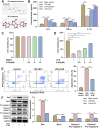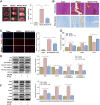4-Hydroxysesamin, a Modified Natural Compound, Attenuates Neuronal Apoptosis After Ischemic Stroke via Inhibiting MAPK Pathway
- PMID: 38469210
- PMCID: PMC10926873
- DOI: 10.2147/NDT.S444760
4-Hydroxysesamin, a Modified Natural Compound, Attenuates Neuronal Apoptosis After Ischemic Stroke via Inhibiting MAPK Pathway
Abstract
Background: The 4-hydroxysesamin (4-HS, a di-tetrahydrofuran lignin) is a modified sesamin that was prepared in the laboratory. This preclinical study was designed to preliminarily investigate the neuroprotective properties of 4-HS.
Methods: In vitro, neuronal injury and inflammation were simulated by oxygen-glucose deprivation and lipopolysaccharide (LPS) exposure in mouse hippocampal neuronal HT22 cell line, and treated with 4-HS and/or metformin (MET, MAPK pathway activator for exploring mechanism). CCK-8, flow cytometry, and enzyme-linked immunosorbent assay were performed to evaluate cell viability, apoptosis, and inflammation. Apoptosis- and pathway-related proteins were detected by Western blotting. Middle cerebral artery occlusion (MCAO) was constructed as a stroke model and treated with 4-HS for in vivo confirmation. Histological staining was used for in vivo evaluation of 4-HS properties.
Results: The 4-HS showed similar anti-inflammatory activity to sesamin but did not affect the cell viability of HT22 cells. In vitro, 4-HS improved the cell viability, ameliorated neuronal apoptosis, along with the reversion of apoptotic proteins (Bax, cleaved-caspase 3/9, Bcl-2) expression and inflammatory cytokines (IL-6, TNF-α, IL-10) in LPS-treated HT22 cells. The 4-HS suppressed the phosphorylation of ERK, JNK, and p38 but the addition of MET reversed 4-HS-induced changes of phenotype and protein expression in LPS-treated cells. In vivo, 4-HS showed apparent improvement in cerebral infarction, brain tissue morphology, neuronal architecture, apoptosis, and inflammation of MCAO mice, and also showed inhibiting effects on the phosphorylation of ERK, JNK, and p38, confirming in vivo results.
Conclusion: In this first pre-clinical study on 4-HS, we preliminarily demonstrated the neuroprotective properties of 4-HS both in cell and animal models, and proposed that the underlying mechanism might be associated with the MAPK pathway.
Keywords: 4-hydroxysesamin; ischemic stroke; middle cerebral artery occlusion; neuronal apoptosis; sesamin.
© 2024 Wang et al.
Conflict of interest statement
The authors declare that they have no conflicts of interest in this work.
Figures



References
LinkOut - more resources
Full Text Sources
Research Materials
Miscellaneous

